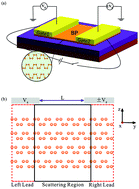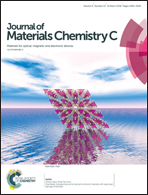A novel electrically controllable volatile memory device based on few-layer black phosphorus†
Abstract
Exploiting the unique property of two dimensional material black phosphorus (BP), we theoretically propose a novel volatile memory device based on pure few-layer BP from atomic first principles calculations. When the vertical gate is applied in the system, the semi-conducting few-layer BP can be driven into the metallic phase. By investigating the local density of states (LDOS) under the gate voltage, we find that the metallic electronic states around the Fermi level mostly localize in the topmost or bottom layer depending on the sign of the gate voltage. Through designing a two-probe device with dual vertical gates applied in the electrode region, a metal–semiconductor–metal tunnelling device can be formed. Two states (“ON” and “OFF”) are realized by the different tunnelling effects of the metallic states from the topmost layer to the topmost layer or the topmost layer to the bottom layer. Due to the anisotropy property of few-layer BP, the relative current ratios of the two states along the armchair direction and zigzag direction are both large and quite different. We predict a giant “ON/OFF” current ratio that can be over 5000% along the zigzag direction, which indicates that the few-layer BP is a potential candidate in atomically-thin volatile memory devices.



 Please wait while we load your content...
Please wait while we load your content...